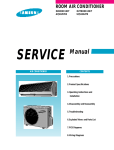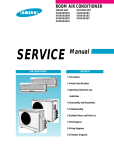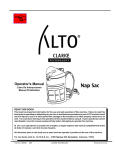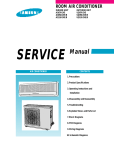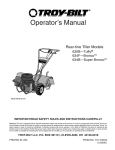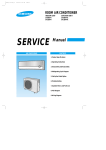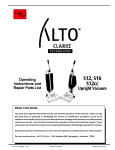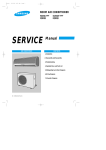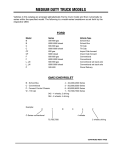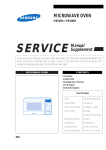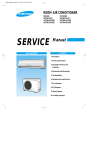Download Samsung AQV12J Series Product specifications
Transcript
ROOM AIR CONDITIONER INDOOR UNIT AQV12F2VE SERVICE OUTDOOR UNIT UQV12A0TE Manual AIR CONDITIONER CONTENTS 1. Precautions 2. Product Specifications 3. Operating Instructions and Installation 4. Disassembly and Reassembly 5. Troubleshooting 6. Exploded Views and Parts List 7. PCB Diagrams 8. Wiring Diagrams 1. Precautions 1. Warning: Prior to repair, disconnect the power cord from the circuit breaker. 2. Use proper parts: Use only exact replacement parts. (Also, we recommend replacing parts rather than repairing them.) 3. Use the proper tools: Use the proper tools and test equipment, and know how to use them. Using defective tools or test equipment may cause problems later-intermittent contact, for example. Fig. 1-1 Avoid Dangerous Contact 4. Power Cord: Prior to repair, check the power cord and replace it if necessary. 5. Avoid using an extension cord, and avoid tapping into a power cord. This practice may result in malfunction or fire. 6. After completing repairs and reassembly, check the insulation resistance. Procedure: Prior to applying power, measure the resistance between the power cord and the ground terminal. The resistance must be greater than 30 megohms. Fig. 1-2 No Tapping and No Extension Cords 7. Make sure that the grounds are adequate. 8. Make sure that the installation conditions are satisfactory. Relocate the unit if necessary. 9. Keep children away from the unit while it is being repaired. 10. Be sure to clean the unit and its surrounding area. Fig. 1-3 No Kids Nearby! Fig. 1-4 Clean the Unit Samsung Electronics 1-1 2. Product Specifications 2-1 Table Model (Indoor) (Outdoor) ø-V-Hz Capacity W Btu/h Cooling Energy efficiency ratio Btu/wh Air flow m2/min Moisture removal L/h Noise level Indoor Performan dBA Outdoor ce Capacity W Btu/h Heating Energy efficiency ratio Btu/wh Air flow m3/min Noise level Indoor dBA Outdoor Available voltage range V Running amperes A Cooling Power input W Power factor % Running amperes A Electrical Heating Power input W Rating Power factor % Starting current A Fuse capacity AXV Power cord AXV Cable-connector mm2 X C Type Compre Model name ssor Safety devices Indoor Model name Fan Running capacitor µF X VAC Outdoor Model name motor Running capacitor µF X VAC Refrigerant tube Narrow tube : Liquid mm X MT Wide tube : Gas mm X MT Capillary tube Cooling mm Heating mm Refrigerant to charge (R22) gr Dimension Indoor unit : W x H x D Outdoor unit : W x H x D Weight Indoor unit Outdoor unit AQV12F2VE UQV12A0TE 1-220/240-50 3,500 (2,580~4,100) 12,000 (8,800~14,000) 9.4 (11.3~8.4) 8.4 1.9 36~40 51 3,800 (2580~4830) 13,000 (8800~16500) 9.8 (11.9~8.2) 8.8 34~38 52 187~264 5.6 (3.7~7.1), (MAX 12A↓) 1,280 (780~1,650) 95.0 (90.0~97.0) 5.7 (3.3~8.5), (MAX 12A↓) 1,330 (740~1,980) 98.0(94.0~97.0) 12 ↓ 3.15X250 / 20X250 12 X 250 1.5 X 4 Single Rotary 48V135RV1E4 204CT AMPFS-040WTVB 1.5 X 450 AMASS-020WTVB 1.5 X 450 OD6.35 X 5 OD12.7 X 5 ID1.7 X 800 ID1.7 X 600 1,000 815x298x193 762x532x280 9.2 44.0 Item Power Source Remark : Text condition Samsung Electronics Indoor room Outdoor room Cooling test DB27˚C / WB19˚C DB35˚C / WB24˚C Heating test DB20˚C / DB 7˚C / WB 6˚C - Remark 2-1 2-2 Dimensions 2-2-1 Indoor Unit (Remote control) (Front view) Air in Air out (Rear view) Installation plate 2-2-1 Outdoor Unit (Front view) 2-2 (Rear view) Samsung Electronics 2-3 Refrigerating Cycle Block Diagram INDOOR UNIT OUTDOOR UNIT Capillary tube T 2-way valve Check valve Liquid side Capillary tube Heat exchanger (Evaporator) Heat exchanger (Condenser) T Gas side 3-way valve 4-way valve Cooling Compressor Heating Gas leak check point Samsung Electronics 2-3 3. Operating Instructions and Installation 3-1 Operating Instructions 3-1-1 Name & Function of Key in remote controller NO FUNCTION OF KEY NAMED OF KEY On/Off Button. Use this button to start and stop air conditioner. 1 2 (UP) Temp up button. If the button is pressed once, the setting temperature is increased by 1°C (DOWN) Temp down button. If the button is pressed once, the setting temperature is decreased by 1°C Each time you press this button, MODE is changed in the following order. 3 MODE : Auto Mode : Fan Only Mode : Cool Mode : Heat Mode : Dry Mode 4 TURBO Use this button to provide heavy duty cooling & Heating for 30 minutes. 5 OFF Set up the reserve or cancel the timer on and timer off quickly 6 Use this button for sleep operation. (The SLEEP mode can be selected at COOL and HEAT mode.) 7 Adjusts air flow vertically. Each time you press this button, FAN SPEED is changed in the following order. 8 9 10 11 12 13 C O V E R T I M E R ON TIMER Set up the time that operation start. OFF TIMER Set up the time that operation stop. SET Use this button to reserve the timer on. CANCEL Use this button to reserve or cancel the timer on and timer off. (UP) If the button is pressed once, the time increase by one minute during the time set mode, and ten minutes during the timer set mode. (DOWN) If the button is pressed once, the time decrease by one minute during the time set mode, and ten minutes during the timer set mode. 14 15 TIME Samsung Electronics Without regard to ON/OFF condition in remote controller, use this button to set current time. Adjust the current time using button. (Data can be transmitted after setting up the time) 3-1 Operating Instructions and Installation 3-1-2 Name & Function of Key in remote controller 1. AUTO MODE : In this mode, operation mode(COOL, HEAT) is selected automatically by the room temperature of initial operation. Room Temp Operation Type Tr≥ 21°C+∆T Cool Operation (Set Temp:24°C+∆T) 21°C +∆T>Tr Heat Operation (Set Temp : 22°C+∆T) ∆T= -2°, -1°C, 0°C+1°C+2°C ∆T is controlled by setting temperature up( )/down( ) key of remote controller 2. COOL MODE : The unit operates according to the difference between the setting and room temperature. (18°C~30°C) 3. HEAT MODE : The unit operates according to the difference between the setting and room temperature.(16°C~30°C) *Prevention against cold wind : For about 3~5 minutes after initial operation, thermo control or “defrost”, the indoor fan will either not operate or operate very slowly, then switch to the selected fan speed. This period is to allow the indoor unit's heatexchanger to prewarm before emitting warm air. *High temperature release function : The outdoor unit for and compressor ON/OFF control for safety operation, when the overheat is heat exchanger of indoor unit. *Defrost : Deicing operation is controlled by outdoor unit's heat exchanger temperature and outdoor temperature and accumulating time of compressor's operation. De-ice end by sensing of the processing time by de-ice Condition. 3-2 4. DRY MODE : The unit operates in DRY mode. *Protective function : Low temperature release. (Prevention against freeze) 5. TURBO MODE : This mode is available in AUTO, COOL, HEAT, DRY, FAN, SLEEP Mode. When this button is pressed at first, the air conditioner is operated “powerful” state for 30 minutes regardless of the set temperature, room temperature. When this button is pressed again, or when the operating time is 30 minutes, turbo operation mode is canceled and returned to the previous mode. *But, if you press the TURBO button in DRY or FAN mode that is changed with AUTO mode automatically. 6. SLEEP MODE : Sleep mode is available only in COOL or HEAT mode. The operation will stop after 6 hours. *In COOL mode : The setting temperature is automatically raised by 1°C each 1hour When the temperature has been raised by total of 2°C, that temperature is maintained. *In HEAT mode : The setting temperature is automatically droped by 1°C each 1hour. When the temperature has been droped by total of 2°C, that temperature is maintained. 7. FAN SPEED : Manual / Auto Fan speed automatically varies depending on both the difference between setting and the room temperature. Samsung Electronics Operating Instructions and Installation 8. COMPULSORY OPERATION : For operating the air conditioner without the remote controller. *AUTO : The operating is the same function that AUTO MODE in the remote controller. 9. SWING : BLADE-H is rotated vertically by the stepping motor. *Swing Set / Auto : Press the button under the remote control is displayed on LCD the , and the blades move up and down, about 43°. If the one more time press the button, blatles location is stop. 10. Quick OFF TIMER: OFF timer (quick timer) allows reservation or cancel the timer on and timer off quickly When OFF timer button is pressed at operating state, LCD displays the polling state sequentially. The LCD also displays the time remaining. 11. 24-Hour ON/OFF Real Setting Timer. : The air conditioner is turned ON at a specified time using ON TIMER . OFF TIMER : The air Conditioner is turned OFF at a specified time using OFF TIMER . *ON TIMER : Only timer LED lights on. *OFF TIMER : Both timer and operation LED lights on. 12. BUZZER SOUND : Whenever the ON/OFF button is pressed or whenever change occurs to the condition which is set up or select, the compulsory operation mode, buzzer is sounded "beep" 13. SELF Diagnosis The indoor unit observes operation of the air-conditioner, and displays the results of self diagnosis on display pannel. Samsung Electronics Error mode Opera- Defrost Reserva- Power tion tion monitor X X X Fan Turbo X X X X X Operation off X X X X X Power reset X X X X Trouble of indoor temperature sensor (open/short) X X X X Temperature sensor trouble of the indoor heat exchanger (open/short) X Stuck of the indoor fan motor (trouble of rotation) X Trouble of outdoor unit temperature sensor - Discharge temperature sensor - OLP temperature sensor of COMP top - Defrost temperature sensor - Outdoor temperature sensor X Communication trouble between the indoor and outdoor units (Misconnection or circuit trouble of the indoor and outdoor units) X X X X X X X X X X X X X X X X X X X Abnormal increase of the operation current X X Occurring of the inverter circuit instantaneous over current. X Abnormal increase of the COMP. Top and discharge gas temperature. LAMP ON Refrigerant Refill operation (test operation) (Lamp status) : Lamp flickering X: Lamp off 14. AUTO RESTART : The air conditioner starts immediately without control of remote controller when plugged. It’s the case that the Auto-restart fanction works. * Auto restart function is the convenient function where the operation state is memorized in the Memory IC during the blackout and the operation restarts when the power comes back. 3-3 3-2 Installation (Fix the unit firmly if it is mounted in a high place.) 3-2-1 Selecting Area for Installation Select an area for installation that is suitable to the customer's needs. 3-2-1(a) Indoor Unit 1. Make sure that you install the indoor unit in an area providing good ventilation. It must not be blocked by an obstacle affecting the airflow near the air inlet and the air outlet. 2. Make sure that you install the indoor unit in an area allowing good air handling and endurance of vibration of the indoor unit. 3. Make sure that you install the indoor unit in an area where there is no source of heat or vapor nearby. 4. Make sure that you install the indoor unit in an area from which hot or cool air is spread evenly in a room. 3. Make sure that you install the outdoor unit in area providing good ventilation and which is not dusty. It must not be blocked by any obstacle affecting the airflow near the air inlet and the air outlet. 4. Make sure that you install the outdoor unit in area free from animals or plants. 5. Make sure that you install the outdoor unit in area not blocking the traffic. 6. Make sure that you install the outdoor unit in area easy to drain condensed water from the indoor unit. 7. Make sure that you install the outdoor unit in area which provides easy connection within the maximum allowable length of a coolant pipe(10 meters). Note 1. Add 10 grams of refrigerant (R-22) for every 1 meter if the pipe length exceeds the standard pipe length of 5 meters. 2. Maintain a height between the indoor and outdoor units of less than 3 meters. 5. Make sure that you install the indoor unit in an area away from TVs, audio units, cordless phones, fluorescent lighting fixtures and other electrical appliances (at least 1 meter). 6. Make sure that you install the indoor unit in an area which provides easy pipe connection with the outdoor unit, and easy drainage for condensed water. 8. Make sure that you install the outdoor unit in an area which is large enough to accommodate the measurements shown in figure on the next page. 7. Make sure that you install the indoor unit in an area which is large enough to accomodate the measurements shown in figure on the next page. 3-2-1(c) Remote Control Unit 3-2-1(b) Outdoor Unit 1. Make sure that you install the outdoor unit in area not exposed to the rain or direct sun light. (Install a separate sunblind if exposed to direct sun light.) 2. Make sure that you install the outdoor unit in area allowing good air moment, not amplifying noise or vibration, especially to avoid disturbing neighbours. 1. Make sure that you install the remote control unit in an area free from obstacles such as curtains etc, which may block signals from the remote control unit. 2. Make sure that you install the remote control unit in an area not exposed to direct sunlight, and where there is no source of heat. 3. Make sure that you install the remote control unit in an area away from TVs, audio units, cordless phones, fluorescent lighting fixtures and other electrical appliances (at least 1 meter). Caution : It is harmful to the air conditioner if it is used in the following environments: greasy areas (including areas near machines), salty areas such as coast areas, areas where sulfuric gas is present such as hot spring areas. Contact your dealer for advice. 3-4 Samsung Electronics Operating Instructions and Installation 3-2-2 Installation diagram of indoor unit and outdoor unit A Indoor unit gas leak test check point Piping may be laid to the rear, left, right or down . 3 Indoor unit Left Right 2 Rear Piping Down Rear Tape vinyl 1 B Drain hose installation 100mm or more 160mm or more Cut the piping hole sloped slightly 7 8 9 5 6 Remote control Remote control holder 4 10 1 2 3 4 5 Samsung Electronics 9K BTU 12K BTU Piping (Liquid) 1/4" 6 Clamper tube Piping(Gas)3/8” Piping(Gas)1/2” 7 Installation plate 8 Pipe-connection Screw Drain hose Installation tube Vinyl tape Putty 9 10 3-5 Operating Instructions and Installation 3-2-2(a) Fixing the Installation Plate 1. Determine the position of the pipe and drain hose hole using the right figure and drill the hole with an inner diameter of 65mm so that it slants slightly downwards. Installation plate 2. If you are fixing the indoor unit to a… Then follow Steps… Pipe hole (ø65mm) Wall 3. Window frame 4 to 6. 3. Fix the installation plate to the wall in a manner appropriate to the weight of the indoor unit. (Unit : mm) If you are mounting the plate on a concrete wall with anchor bolts, the anchor bolts must not project by more than 20mm. 280 (Unit : mm) 340 4. Determine the positions of the wooden uprights to be attached to the window frame. 5. Attach the wooden uprights to the window frame in a manner appropriate to the weight of the indoor unit. 6. Using tapped screws, attach the installation plate to the wooden uprights, as illustrated in the last figure opposite. 3-2-2(b) Purging the Unit On delivery, the indoor unit is loaded with an inert gas. All this gas must therefore be purged before connecting the assembly piping. To purge the inert gas, proceed as fol lows. Unscrew the caps at the end of each pipe. Result : All inert gas escapes from the indoor unit. • 3-6 To prevent dirt or foreign objects from getting into the pipes during installation, do NOT remove the caps completely until you are ready to connect the piping. Samsung Electronics Operating Instructions and Installation 3-2-2(c) Connecting the Assembly Cable. The outdoor unit is powered from the indoor unit via the assembly cable. If the outdoor unit is more than five metres away from the indoor unit, the cable must first be extended to a maximum of ten metres. 1. Extend the assembly cable if necessary. Indoor unit 2. Open the front grille by pulling on the tabs on the lower right and left sides of the indoor unit. 3. Remove the screw securing the connector cover. Earth terminal 4. Pass the assembly cable through the rear of the indoor unit and connect the assembly cable to terminals C, N, L, E. • Each wire is labelled with the corresponding terminal number. Earth terminal Outdoor unit L : Brown N : Sky blue C : Black E : Yellow/ Green 5. Firmly fix the ass’y cable with clamp wire holder. 6. Pass the other end of the cable through the 65mm hole in the wall. 7. Replace the connector cover, carefully tightening the screw. 8. Close the front grille. 3-2-2(d) Installing and Connecting the Indoor Unit Drain Hose Care must be taken when installing the drain hose for the indoor unit to ensure that any condensa tion water is correctly drained outside.l When passing the drain hose through the 65mm hole drilled in the wall, check that none of the following situations occur. The hose must NOT slope upw ards. The end of the drain hose must NOT be placed in water. Do NOT bend the hose in different directions. Keep a clearance of at least 5cm between the end of the hose and the ground. Do NOT place the end of the drain hose in a hollow. To install the drain hose, proceed as follows. 1. If necessary, connect the 2-metre extension to the drain hose. 2. If you are using the extension, insulate the inside part of the extension drain hose with a shield. 3. Pass the drain hose under the refrigerant piping, taking care to keep the drain hose tight. 4. Pass the drain hose through the hole in the wall, making sure that it is sloping downwards, as shown in the illustrations above. Shield Drain hose Samsung Electronics Extension drain hose 3-7 Operating Instructions and 3-2-2(e) Outdoor unit installation Wiring connection 1. 2. 3. 4. 5. Remove the Handle-Cabi RH. Firmly connect the cable connector in the terminal block. Fasten the terminal to the hole marked Firmly fix the ass'y cable with clamp wire holder. Assemble the Handle-Cabi RH. Installing and Connecting the Outdoor Unit Drain Hose Drain hole 3-8 When using the air conditioner in the heating mode, ice may accumu late. During de-icing, the condensed water must be drained off safely. Consequently, you must install a drain hose on the outdoor unit, fol lowing the instructions below. 1 Insert the drain plug into the drain hole on the underside of the outdoor unit. 2 Connect the drain hose to the drain plug. 3 Ensure that the drained water runs off correctly and safely. Samsung Electronics Operating Instructions and Installation 3-2-2(f) Flare Modification • Tools used Flare modification procedure 1) Cut the pipe using a pipe cutter. 2) Remove burrs at the tip of the pipe cut. Caution : Burrs not removed may result in leakage of gas. Pipe Oblique Raughness 3) Insert a flare nut into the pipe and modifty flare. Reamer Burr D Outer diameter ø6.35mm ø9.52mm ø12.7mm A A(mm) 1.3 1.8 2.0 * Unproper flaring Inclined Samsung Electronics Surface damaged Cracked Uneven thickness 3-9 Operating Instructions and Installation 3-2-2(g) Air-Purge Procedure • Use the refrigerant of the outdoor unit to purge air inside indoor unit and pipe. 1. Remove the caps from the 2-way valve(B) and the 3-way valve(A). 2. Turn the 2-way valve cock approx. 45° counterclockwise to open it. Close it about 10 seconds later. Valve stem Valve stem Stopper 3. Check refrigerant leakage of each joint parts (A, B, C & D in right figure) not leaking Leaking If leaking, tighten the flare nut one more time. If continues to leak, although the pipe fixing area has been tightened again, repair the leaking area. 4. Open the 2-way valve again. Indoor Unit 5. Open the service valve cap of the 3-way valve and press the needle valve to discharge gas for 3 seconds and leave it for about 1 minute. Repeat the above procedure for 3 times to purge air. 6. Open the 2-way valve and 3-way valve completely Liquid pipe side Gas pipe side 2-way valve 3-way valve Outdoor Unit 7. Close the cap of each valve. 8. Check each valve for leakage. 3-10 Samsung Electronics Operating Instructions and Installation 3-2-2(h) Refrigerant Refill • Refill an air-conditioner with refrigerant when refrigerant has been leaked at installing or using 1. Purge air(for new installation only). 2. Turn the 3-way valve clockwise to close, connect the pressure gauge(low pressure side) to the service valve, and open the 3-way valve again. Press this ON/OFF Switch for 5sec. And then the Aircondationer operating on rating speed. 3. Connect the tank to refill with Refrigerant ON/OFF 4. Set the unit to Low pressure checking mode. * Press the ON/OFF switch for 5 second. *All the lamp is blink on the indoor unit. 5. Check the pressure indicated by the pressure gauge(low pressure side). * Refer to Low pressure graph. Suspension hook High pressure gauge Compound gauge Hand wheel 6. Open the refrigerant tank and fill with refrigerant until the rated pressure is reached. * It is recommended not to pour the refrigerant in too quickly, but gradually while operating a pressure valve. Finger tight fittings For mounting other and of hose when not in use Connected to high pressure side Charging line 7. Stop operation of the air conditioner. 8. Close the 3-way valve, disconnect the pressure gauge, and open the 3-way valve again. 9. Close the cap of each valve. Samsung Electronics 3-11 Operating Instructions and Installation 6.5 32.4 6 30.6 5.5 28.8 27.0 5 24.0 4.5 21.5 4 3.5 20 25 30 35 40 45 Outdoor inlet air DB temp.(˚C) 3-2-2(i) Refrigerant Adjustment Class Connection Pipe Length 5m Max. At installation At service Air-Purge Method Refrigerant Adjustment Air-Purge Method Refer to the detailed Air-Purge Procedure Unnecessary Add 10g of refrigerant (R-22) for every 1m. 5~10m Purge air using a vaccum pump or an additional refrigerant cylinder. Refrigerant Quantity refer to specification sheet Add 10g of refrigerant (R-22) for every 1m. 3-2-2(j) Flare unt fixing torque Outter diameter 3-12 Torque (kg-cm) Fixing Torque Final Torque ø 6.35 (9000Btu, 12000Btu) (Liquid Side) 160 200 ø 9.52 (9000Btu) (Gas Side) 300 350 ø 12.7 (12000Btu) (Gas Side) 500 550 Samsung Electronics Operating Instructions and Installation 3-2-2(k) "Pump down" Procedure • Pump down' shall be carried out when an evaporator is replaced or when the unit is relocated in another area. 1. Remove the caps from the 2-way valve and the 3-way valve. 2. Turn the 3-way valve clockwise to close and connect a pressure gauge(low pressure side) to the service valve, and open the 3-way valve again. (liquid) (gas) 3. Set the unit to cool operation mode. (Check if the compressor is operating.) Valve stem 4. Turn the 2-way valve clockwise to close. Stem cap 3-Way Valve 2-Way Valve 5. When the pressure gauge indicates "0" turn the 3-way valve clockwise to close. 6. Stop operation of the air conditioner. 7. Close the cap of each valve. Relocation of the air conditioner • Refer to this procedure when the unit is relocated. 1. Carry out the pump down procedure (r efer to the details of 'pump down'). 2. Remove the power cord. 3. Disconnect the assembly cable from the indoor and outdoor units. 4. Remove the flare nut connecting the indoor unit and the pipe. At this time, cover the pipe of the indoor unit and the other pipe using a cap or vinyl plug to avoid foreign material entering. Samsung Electronics 5. Disconnect the pipe connected to the outdoor unit. At this time, cover the valve of the outdoor unit and the other pipe using a cap or vinyl plug to avoid foreign material entering. 6. Make sure you do not bend the connection pipes in the middle and store together with the cables. 7. Move the indoor and outdoor units to a new locatioon. 8. Remove the mounting plate for the indoor unit and move it to a new location. 3-13 4. Disassembly and Reassembly Stop operation of the air conditioner and remove the power cord before repairing the unit. 4-1 Indoor Unit No Parts 1 Front Grille Procedure Remark 1) Stop the air conditioner operation and block the main power. 2) Separate tape of front panel upper. 3) Contract the second finger to the left, and right handle and pull to open the inlet grille. 4) Take the left and right filter out. * Take the Deadorizing and Electrostatic filter out. (ONLY “1” and “5” Series models) 5) Loosen one of the right fixing screw and separate the terminal cover. 6) Loosen three fixing screws of front grille. 7) Pull the upper left and right of discharge softly for the outside cover to be pulled out. 8) Pull softly the lower part of discharge and push it up. Caution; Assemble the front panel and fix the hooks of left and right. Samsung Electronics 4-1 Disassembly and Reassembly No Parts 2 Ass’y Tray Drain. 3 Electrical Parts (Main PCB) Procedure Remark 1) Do “1”, above. Separate the drain hose from the extension drain hose. 2) Take the display PCB out. (Center of indoor unit) 3) Loosen three fixing screws of left and right 4)Pull tray drain out from the back body. 1) Do “1”, “2”, above 2) Take all the connector of PCB upper side out. (Inclusion Power cord) 3) Separate the outdoor unit connection wire from the terminal block. 4) If pulling the Main PCB up. it will be taken out. (Separate the TRANS hook. it before). 4 Heat Exchanger 1) Do “1” and “2”, “3”, above 2) Loosen two fixing earth screws of right side. 3) Separate the connection pipe. 4) Separate the bush body at the upper side and holder at the rearside. 5) Loosen the two fixing screws of left side. 6) Lifting the heat exchanger up a little to push the up side for separation from the indoor unit. 4-2 Samsung Electronics Disassembly and Reassembly No Parts 5 Fan Motor and Cross Fan Procedure Remark 1) Do “1” “2” ”3” “4”, above. 2) Loosen the fixing three screws and separate the motor holder. 3) Loosen the fixing screw of fan motor. (By use of M3 wrench) 4) Separate the fan motor from the fan. 5)Separate the fan from the left holder bearing. Samsung Electronics 4-3 4-2 Outdoor Unit Take care of the electrical shock by contact on the charging parts before the discharge after power off. (If takes approximately 2minutes to discharge.) No Parts 1 Common Work & Ass’y-control Out Procedure Remark 1) Loosen the fixing screw and separate the Handle-Cabi RH. 2) Separate the Cable-Connector Wire from the Terminal-Block. 3) Loosen six fixing screws and separate the Cabi-Upper. 4) Loosen four fixing screws from the Ass’y-Control Out. 5) Separate the Terminal-Housing from the Ass’y-Control Out. 6) Separate the Ass’y-Control Out from the outdoor unit. 7) Loosen five fixing screws and separate the Cabi-Side. 4-4 Samsung Electronics Disassembly and Reassembly No Parts 2 Fan-Motor Procedure Remark 1) Loosen fixing screw of the Guard-Fan. 2) Turn the Guard-Fan to separate from the Cabi-Front. 4) Remove the nut flange (Turn to the right to remove, as it is a left hand screw) 5) Separate the fan. 6) Loosen four fixing screws to separate the motor. 3 Heat Exchanger Samsung Electronics 1) Do “1”, above. 2) Loosen four fixing screws of Ass’y-Frame and Partition. 3) Disassemble the inlet and outlet pipe by welding. 4) Separate the heat exchanger. 4-5 Disassembly and Reassembly No Parts Procedure 4 Compressor 1) Do “1”, above. 2) Open the terminal cover of compressor and unscrew the connection terminal. 3) Disassemble the inlet and outlet pipe of compressor by welding. 4) Disassemble the inlet and outlet pipe of condenser by welding Remark 5) Loosen the three bolts of the lower part. 6) separate the compressor. 4-6 Samsung Electronics 5. Troubleshooting Since the inverter air conditioner is equipped with Electrical control circuits at both Indoor & outdoor unit, the trouble shooting shall be performed according to the error mode. Inside the controller of the outdoor unit (inverter), the large capacity of electrolytic condenser so that it takes the time to discharge after the power off since the electrical charge remains (the charging voltage DC 340V). Take care of the electrical shock by contact on the charging part before the discharge after the power off. (It takes approximately 2 minutes to discharge). 5-1 Basic items for trouble shooting 1) Is the power source proper? The power source shall be in the range of the rated voltage ±10%. If it is out of this range, it may cause the abnormal operation. 2) Is the connection made between the indoor and outdoor unit? The connection between indoor and outdoor unit shall be performed with 4 wire. (connection cable of indoor and outdoor unit + ground wire). 3) The phenomena as follows are not out of order. NO Phenomena 1 The operation is not done. Cause and reason Is the power off or the power unplugged? Does it stop because it is the completion time? • Unplug and plug again the power source for 2 minutes. • • 2 The wind comes out but the heating/cooling is not performed. Is the filter clogged with dust or dirty? Is there any direct light on the outdoor unit or any obstacle against it? • Is the selected temperature too high? Lower the selected temperature lower than the current one (during cooling). • Is the selected temperature too low? Raise the desired temperature than the current one? • Is the “Fan only Mode” operation? 3 The remote controller does not operate. • 4 The wind volume is not adjusted. • 5 The reservation does not operate. 6 The temperature is not set. 7 The operation lamp continues to be flickering. • • Is the battery run out? Is the battery inserted in the wrong way(+, -)? • Is the detection part of the indoor unit blocked? • Does it interfered with the radio of neon sign? • Is the operation selected among one of Auto / Dry / Turbo / Sleeping? The temperature setting is not required since the wind volume set automatically. • Check again at the state of Cooling / Fan only / Heating. • • • Is the current time input? The reservation can be made only when the current time is input. Is it on the stop condition? The reservation can not be made at the stop state. Press the Operation / Stop button to make the reservation. Is the operation selected among the Dry / Turbo / Sleeping / Fan only Mode. Since the temperature is automatically set, the temperature setting is not required. • Check again at the cooling/heating state. • The standard temperature ±2˚C during the automatic operation. • • • Push the Operation / Stop button. Unplug and plug the power source. 8 The immediate operation starts • It is the case that the auto restart function works. without control of remote # Auto restart function is the convenient function where the operation state is memorized in controller when plugged the Memory IC during the blackout and the operation restarts when the power comes back. Samsung Electronics 5-1 5-2 The first determination method of troubled part 5-2-1 Error mode display of indoor unit Operation Defrost Reservation X X X X X X X Error mode Fan Turbo X X X Operation off X X X Power reset X X X X Trouble of indoor temperature sensor (open/short) X X X X Temperature sensor trouble of the indoor heat exchanger (open/short) X Stuck of the indoor fan motor (trouble of rotation) X X Trouble of outdoor unit temperature sensor - Discharge temperature sensor - OLP temperature sensor of COMP top - Defrost temperature sensor - Outdoor temperature sensor X X Communication trouble between the indoor and outdoor units (Misconnection or circuit trouble of the indoor and outdoor units) X X X X X X X X X X X X X X Power monitor X X X Abnormal increase of the operation current X X Occurring of the inverter circuit instantaneous over current. X LAMP ON Abnormal increase of the COMP. Top and discharge gas temperature. Refrigerant Refill operation (test operation) (Lamp status) : Lamp flickering 5-2 X: Lamp off Samsung Electronics Troubleshooting 5-2-2 Error mode display of outdoor unit board ERROR MODE RED GREEN X X YELLOW X Operation off X Indoor-outdoor unit normal communication and operation X X Abnormal communication between the indoor and outdoor unit (miconnection or trouble of circuit between the indoor and outdor unit) X X X Trouble of the control power of the outdoor(+12V) X X Instantaneous over current of inverter circuit X Abnormal increase of the discharge temperature Abnormal increase of operation current X Abnormal increase of comp top temperature. X Trouble of outdoor temperature sensor (open/short) Trouble of the OLP temperature sensor (open/short) Trouble of outdoor Heat exchanger temperature sensor (defrost temperature sensor) (open/short) (LAMP ) : LAMP ON : LAMP FLICKERING X : LAMP OFF Samsung Electronics 5-3 5-3 Sequence of trouble shooting for inverter aircon OPERTION START . The indoor unit does not work even though the power is plugged. . There is no sound “ting” . The lamp is not on the display. Check the indoor unit control board. (A) The indoor unit does not work when operated by the remocon. Checking the Remocon. (B) Check the control board and the display board of indoor unit.(C) The lamp of the indoor display lamp is flickering and the indoor unit stops several minutes after the indoor unit starts. Check the error mode by confirming the lamp flickering of indoor unit display.(D~N) Reservation lamp( ) flickering -> Check of the indoor temperature sensor (D) Operation( ), Reservation( ) lamp flickering -> Check of the indoor heat exchanger (E) Fan( ) lamp flickering -> Check of indoor unit fan motor (F) Reservation( Operation( Turbo lamp( ), Fan( ), Fan ( ) lamp flickering ) lamp flickering -> Check of the outdoor unit temperature sensor : Discharge temperature sensor (H) : Comp top OLP temperature sensor (I) : Defrost temperature sensor (J) : Outdoor temperature sensor (K) ) flickering Reservation( ), Turbo( ) lamp flickering Fan( ), Turbo lamp( ) flickering 5-4 -> Check the lines of the indoor and outdoor communication (G) Check the indoor unit Check of the Communication line Check of the Outdoor unit -> Check of the abnormal increase protection of the operation Current (L) -> Check of the instantaneous over-current protection mode of inverter circuit (M) -> Check the abnormal increase of the comp top and discharge gas temperature protection mode.(N) Samsung Electronics Troubleshooting 5-3-1 (A) Check of indoor unit control board Unplug the power cord and plug it after 5 seconds. Open the grille of indoor unit and press the on/off switch located inside to operate the air conditioner. •If the air conditioner operates, check the remocon and indoor unit display board. •If the air conditioner does not operate, check according to the sequence of the followings: Check sequence of indoor unit control board Step 1 : Check whether two wires of power cord (Sky-blue, brown) are connected correctly to the control board. •Sky -blue : connected to TB71 •Brown : connected to #4 terminal of RY71. (If it is connected to #3 of RY71, the power is not supplied) Take care. Step 2: Check whether the wire connected to the terminal block is connected correctly to the control board. •Sky -blue : connected to TB72 •Brown : connected to #3 terminal of RY71. •Black : Connected to CN75 Step 3 : Check whether the fuse (F701) on the control board is normal. (3.15 [A]/250[V]) • If the fuse is broken, replace it with the new one. Step 4 : check the output of transformer on the control board (TN71). • Input power AC 240V, 50 Hz—-IC 01 output: DC 12V IC 02 output : DC 5V 5-3-2 (B)(C) Display board and remocon check of indoor unit Check whether the connection wire of Display board is correctly connected to CN92 connector. Check the voltage of remocon battery. - the voltage of one battery shall be higher than about 1.4 V, and then the remocon operates normally. Check whether the neon sign is on and the 3 wave long fluorescent lamp is on around the indoor unit. - After putting all the lamps of the indoor out and then operates it by remocon. If it operates with the remocon, it is the abnormality due to the interference from the lights of lamps. (Aircon unit is normal). 5-3-3 (D)(E) Check the indoor temperature sensor and indoor heat exchanger temperature sensor. Take out the thermistor connected to the connector (CN41) of control board of indoor unit and measure the resistance between two wires and if it is same as follows: it is normal but if not, replace it. Ambient temperature (°C) 15°C 20°C 25°C 30°C 35°C 40°C Resistance of thermistor [KΩ] 14.68 12.09 10 8.31 6.94 5.83 Samsung Electronics The error of data of within 1%. 5-5 Troubleshooting 5-3-4 (F) Check of indoor unit fan motor Check whether the wire of fan motor is connected to the connector of control board (CN43, CN73) of indoor unit. Check whether the error mode displays after the strong revolution for approximately 15 seconds since aircon is on. -> In case the error mode displays after the fan motor is rotating for 15 seconds → Defect of HALL IC of fan motor and Control board -> In case that the error mode displays without running of fan motor after 15 seconds. → Operate with the pin of SSR(SS71) short of indoor unit control board and then if the fan motor does not run, it is the fan motor defect. If it rotates, it is the defect of control board (SS71, IC07, IC04). 5-3-5 (G) Check of communication line between the indoor unit and outdoor unit (Communication error mode) 1) Check of connection Check whether the cable wire connecting the indoor unit with outdoor unit is correctly connected to the C, N, R terminal. (If the wire is connected reversely, the communication error occurs) If the cable connecting the indoor unit and outdoor unit is longer than 20 M, error mode occurs (shorten the cable length). (Check of indoor unit) Check whether the connection wire of the terminal block and control of indoor unit board is correct. ♦Sky -blue : connected to TB72 ♦Brown : connected to #3 terminal of RY71. ♦Black : Connected to CN75 (Check of outdoor unit) Check whether the connection wire of the terminal block and control board of outdoor unit is correct. ♦Sky -blue : connected to TB1 ♦Brown : Fuse terminal - connected to TB72 ♦Black : Connected to CN71(Connected to the R701 line) 2) Check of power supply to the outdoor unit After operation of aircon, select the turbo mode and approximately 3minutes later, check whether the red color lamp of control board (to be seen if the top cover of outdoor unit) is on. -> If the red lamp (LED 3) is not on, check the power part of control board of outdoor unit. ♦Check the connection of reactor, polarity of C-ELEC (2200µF/400V) and connection of two diode - bridge. -> If the red lamp (LED3) is on and green lamp is flickering, it is normal. 5-6 Samsung Electronics Troubleshooting 5-3-6 (H)(I) Check of discharge temperature sensor and comp top OLP temperature sensor. Connector of outdoor unit control board (PIN#3,4 of CN41 - discharge temperature sensor) Pin1, 2 - Take out the thermistor connected to comp top OLP temperature sensor and measure the resistance between two wires and if it is same as follows, it is normal but if not, replace. Ambient temperature (°C) 0°C Resistance of thermistor [KΩ] 553 10°C 362 20°C 30°C 242 166 40°C 165 50°C The error of data of within 5%. 82 5-3-7 (J)(K) Check the defrost temperature sensor and outdoor temperature sensor Connector of outdoor unit control board (PIN#1,2 of CN41 - outdoor temperature sensor) Pin3, 4 - Take out the thermistor connected to defrost temperature sensor and measure the resistance between two wires and if it is same as follows, it is normal but if not, replace it. Ambient temperature (°C) 15°C 20°C 25°C 30°C 35°C 40°C Resistance of thermistor [KΩ] 14.68 12.09 10 8.31 6.94 5.83 The error of data of within 1%. 5-3-8 (L) Check of operation current abnormal rise mode The operation abnormal current mode is the protection control for the safe operation by detecting the operation current of inverter aircon by the current sensor on the control board. If the operation current abnormal rise occurs, ♦The ventilation is not good because the outdoor unit is installed wrong (the ambient temperature is higher than 50 °C) -> Reinstall the outdoor unit so that the good ventilation can be made. ♦If the Refrigerant is overcharged. -> Check the amount of Refrigerant. ♦If the comp is locked. -> Replace the comp. ♦If the comp is operating without the revolution of fan motor. -> Check the fan motor connector, replace the fan motor. ♦If the protection cover is operating with bending to the outdoor. -> Take out the protection cover. ♦If two outdoor units are operating face to face. (the bad ventilation is made) -> Reinstall the outdoor unit for the good ventilation. ♦The air circulation is bad due to the attachment of falling leaves -> Take away the leaves for the good ventilation. Check the elements of current sensor block of the outdoor control board. ♦R801 — 1 KΩ ♦R802 — 1.5 KΩ ♦R803 — 15 KΩ Samsung Electronics 5-7 Troubleshooting 5-3-9 (M) Check of instantaneous over-current protection of inverter circuit. Inverter instantaneous over-current protection mode is the mode to be actuated in order to prevent the damage of elements from the peak current of inverter circuit elements. In case that the inverter circuit instantaneous over-current protection mode actuates. (condition of installation) ♦The ventilation is not good because the outdoor unit is installed wrong (the ambient temperature is higher than 50 (°C) ) -> Reinstall the outdoor unit so that the good ventilation can be made. ♦In case that the operation is made with the cover bent of the outdoor unit. -> Take out the cover. ♦If two outdoor units are operating face to face, (the bad ventilation is made) -> Reinstall the outdoor unit for the good ventilation. ♦The air circulation is bad due to the attachment of falling leaves. -> Take away the leaves for the good ventilation. ♦If the Refrigerant is overcharged. -> Check the amount of Refrigerant. (Unit defect) ♦If the comp is locked. -> Replace the comp. ♦If the comp is operating without the revolution of fan motor. -> Check the fan motor connector and replace the fan motor. ♦In case the parts of the control board is damaged. -> Replace simultaneously the inverter control board and the power TR. If only the inverter control board is replaced with the state the power TR. is damaged, the control board is damaged again. (Same as for the vice versa of the above.) 5-3-10 (N) Check of the comp Top OLP and discharge gas temperature abnormal rise. If the comp top temperature and the discharge gas temperature rises higher than a certain level, it protects the circuit. If the comp top OLP temperature and the discharge gas temperature rises abnormally, (Condition of installation) ♦The ventilation is not good because the outdoor unit is installed wrong (the ambient temperature is higher than 50 (°C) ) -> Reinstall the outdoor unit so that the good ventilation can be made. ♦In case that the operation is made with the cover bent of the outdoor unit. -> Take out the cover. ♦If two outdoor units are operating face to face, (the bad ventilation is made) -> Reinstall the outdoor unit for the good ventilation. ♦The air circulation is bad due to the attachment of falling leaves -> Take away the leaves for the good ventilation. ♦If the refrigerant is insufficient. -> Fill up the amount of refrigerant. 5-8 Samsung Electronics Troubleshooting (Unit defect) ♦If the comp is locked. -> Replace the comp. ♦If the comp is operating without the revolution of fan motor -> Take out the protection cover.(cooling mode) -> Check the fan motor connector and replace the fan motor. 5-4 Check method of major parts NO Parts Check method 1 Inverter controller (outdoor unit controller) 1. Open the top cover of outdoor unit. 2. Separate the connector (3P) connecting the comp from the outdoor unit controller. (wire to wire connector). 3. Operate the aircon in the turbo mode. (operate the outdoor 3 minutes after) 4. Measure the voltage across the terminals of comp connector (3p) from the power TR module if the outdoor fan is running. ( If normal) AC voltage of each terminal is similar. •Phase U-V : AC voltage is measured (80V- 190V) •Phase V-W : AC voltage is measured (80V- 190V) •Phase W-U : AC voltage is measured (80V- 190V) (at AC220V) (If abnormal) •The AC voltage is not measured from any one(or two) of Phase U-V, V-W or W-U. - Check the power TR module. - Check the other parts MEASURING METHOD of INVERTER CONTROLLER Samsung Electronics 5-9 Troubleshooting NO Parts Check method 2 Electrolytic condenser (film condenser) 1. Put off the power. 2. Discharge all of condenser completely. 3. Take the lead out of (±) side completely. 4. Check whether any part of the safety hole is damaged from condenser. 5. Check whether the container is expand or damaged. 6. Check whether the analytical is out. 7. Check whether the normal discharge characteristics are obtained during the energized check of tester. + 2200µF/400V - If it is good, the needle rises but falls down slowly. The needle comes back after the polarity reversed. 3 Bridge Diode block 1. Put off the power. 2. Discharge all of condenser completely. 3. Remove 4 terminals connected to the diode block. 4. Check whether the normal discharge characteristics are obtained during the energized check of tester. ~ ~ ~ ~ Tester rod (-) (+) ~ + ~ ~ ~ 5-10 If it is good one, the resistance •When the tester rod is reversed : 10-20 ohm. ∞ Samsung Electronics Troubleshooting NO Parts 4 Power TR module Check method 1. Put the power off completely. 2. Discharge all of condenser completely. 3. Separate the transistor module from the inverter body. 4. Check the leak current between C and E and B by tester for 6 transistors - + BX BU Tester rod U BY V (+) BV - EV BW BZ EC EU W EW Collector(C) Base(B) U V W BU BV BW BX BY BX (-) + U V W If it is good one resistance 10KΩ ~ 500KΩ + EU EV EW 400Ω ~ 500Ω EC Emitter(E) 5 PC 922 (IC3~IC8) 5. If the power transistor module is defective, check the parts of (PC3~PC8) of control board out of inverter controller. 1 8 2 7 3 6 4 5 Tester rod (+) (-) 7 6 6 7 If it is good one resistance ∞ If the resistance between the 6 and 7 is a couple of Kohm, it is defective. Samsung Electronics 5-11 6. Exploded Views and Parts List 6-1 Indoor Unit 6-1 Samsung Electronics Exploded Views and Parts List ■ Parts List No 1 2 3 4 5 6 7 7-1 7-2 8 9 10 10-1 11 12 13 14 15 16 17 18 19 20 21 CODE NO Description Specification DB64-10179A DB63-30131A DB74-10091A DB63-10427B DB92-00012A DB93-00021A DB94-10088K DB95-20138A DB66-30153A DB96-00017A DB67-30058C DB61-00023A DB65-00008A DB31-10078H DB94-30141A DB94-40017A DB93-10593A DB32-10008D DB39-10062Y DB61-10136A DB61-60093A DB94-20030D DB61-40247A DB70-10618A GRILLE AIR INLET GUARD-AIR FILTER ASS’Y-FILTER COVER-TERMINAL ASS’Y-FRONT PANEL ASS’Y-FRONT PANEL ASS’Y-Display ASS’Y-TRAY DRAIN MOTOR-STEPPING BLADE-H ASS’Y-EVAPORATOR SPACER-EVAP ASS’Y-HOLDER MOTOR TERMIANL-BLOCK MOTOR-FAN IN ASS’Y-C-F-FAN ASS’Y-BEARING ASS’Y-MAIN PCB ASS’Y-MAIN PCB ASS’Y-THERMISTOR ASS’Y-POWER CORD CASE-CONTROL BUSH-BODY ASS’Y-BACK BODY HOLDER-PIPE PLATE-HANGER ABS PP CLEANER/CARBON HIPS ABS ABS ASS’Y ASS’Y DC12V, 600gr HIPS ASS’Y PVC ASS’Y 25A, 300V AMPFS-040WTVB ø95 x 619mm ASS’Y ASS’Y ASS’Y ASS’Y 12A, 250V ABS HIPS HIPS HIPS SGCC-M Samsung Electronics Q’TY Remark AQV12F2VE AQV09F2VE 1 2 (1) 1 1 1 1 1 1 1 1 1 1 1 1 1 1 1 1 1 1 1 1 1 1 2 (1) 1 1 1 1 1 1 1 1 1 1 1 1 1 1 1 1 1 1 1 1 1 OPTION ! ! ! ! ! ! 6-2 6-2 Outdoor Unit 6-3 24 25 26 27 Samsung Electronics Exploded Views and Parts List ■ Parts List No 1 2 3 4 5 6 6-1 7 8 8-1 8-2 8-3 9 10 11 12 13 14 15 16 17 18 19 20 21 21-1 22 22-1 23 24 25 26 27 CODE NO Description Specification DB63-30137A DB60-30004A DB67-50063A DB31-10058E DB90-50132C DB94-00001A DB27-10037A DB64-60137B DB93-00022A DB93-10604B DB93-10604A DB61-10186A DB61-10181A DB72-50574B DB72-50571A DB72-50567A DB95-10248A DB73-10004A DB60-30029A DB63-20003A DB63-10034A DB32-10043B DB60-30018A DB99-10144A DB99-10156A DB75-30104A DB32-10019C DB64-60136B DB72-00032A DB67-90025A DB39-00031A DB99-90033C DB99-90033D DB67-20008A DB73-20026B GUARD-FAN NUT-FLANGE PROPELLER-FAN MOTOR-FAN OUT ASS’Y-FRAME ASS’Y-FRAME ASS’Y-PARTITION REACTOR CABI-UPPER ASS’Y-CONTROL OUT ASS’Y-MAIN PCB-OUT ASS’Y-MAIN PCB-OUT CASE-CONTROL UP CASE-CONTROL OUT CLOTH-COMP BOTTOM CLOTH-COMP SIDE CLOTH-COMP SIDE CLOTH-COMP UPPER COMPRESSOR COMPRESSOR GROMMET-ISOLATOR NUT-WASHER GASKET COVER-TERMINAL THERMISTOR-OLP NUT-FLANGE ASS’Y-4WAY VALVE ASS’Y-4WAY VALVE ASS’Y-CHECK VALVE ASS’Y-CHECK VALVE ASS’Y-CONDENSER ASS’Y-CONDENSER THERMISTOR-OUT CABI-SIDE INSUL-CABI SIDE HANDLE-CABI RH CABLE-CONNECTOR WIRE ASS’Y-FLARE NUT ASS’Y-FLARE NUT DRAIN-PLUG RUBBER-LEG PC/ABS 2C SM20C M6 NTR AS+G/F, Ø405 AMASS-020WTVB ASS’Y ASS’Y ASS’Y 12A, 21mH SECC-P ASS’Y ASS’Y ASS’Y PP PP FELT FELT FELT FELT 48V135RV1E4 Samsung Electronics EPDM HEX 2C MB ZPC EPDM NORYL 204CT M5, SM20C 25Kg/cm2G 25Kg/cm2G ASS’Y ASS’Y ASS’Y ASS’Y ASS’Y SECC-P EVA+PO-PE ABS 12A, 4C 1/4” + 2/1” 1/4” + 3/8” PE NBR Q’TY Remark UQV12A0TE UQV09A0TE 1 1 1 1 1 1 1 1 1 1 1 1 1 1 1 1 3 3 1 1 1 1 1 1 1 1 1 1 1 1 1 1 4 1 1 1 1 1 1 1 1 1 1 1 1 1 1 1 3 3 1 1 1 1 1 1 1 1 1 1 1 1 1 1 4 ! ! ! ! ! 6-4 6-3 Remote Control & PCB Box 6-3-1 Remote Control (DB93-30071H) ■ Parts List No CODE NO Description Specification Q’TY 1 2 3 4 5 6 7 8 9 10 11 12 13 14 15 16 17 DB61-10144A DB61-10145A DB64-20054A DB63-10477A DB74-10084A DB73-20110C DB64-40167A DB64-40166B DB68-10789B DB68-10790A PH-M2 DB67-60061A DB67-60062A DB67-60063A 90 X 250 DB93-40179C DB61-40243A CASE UP CASE LOW DOOR REMOCON COVER BATTERY FILTER REMOCON RUBBER REMOCON INLAY LCD INLAY REMOCON LABEL REMOCON LABEL DOOR SCREW TAP SPRING BATTERY SPRING BATTERY SPRING BATTERY PE BAG ASS’Y PCB REMOCON HOLDER REMOCON ABS ABS ABS ABS PC SILICON PC PC ART 90 ART 90 PH-M2 SUS 304 SUS 304 SUS 304 90 x 250 1 1 1 1 1 1 1 1 1 1 6 1 1 1 1 1 1 6-5 ABS Remark Samsung Electronics Exploded Views and Parts List 6-3-2 PCB Box (Indoor unit) 3 2-1 2-2 3 2 1 ■ Parts List No CODE NO Description 1 DB61-10136A CASE-CONTROL 2 DB93-10593A Ass'y main PCB 2-1 DB09-10188A Micom 2-2 DE26-20154A 2-3 3 Specification Q’TY AQV12F2VE AQV09F2VE 1 1 1 - MB89635R 1 1 Trans-power AC230V DC17V 300mA 1 1 DE32-10037A Fuse 250V 3.15A 1 1 DB93-00021A Ass'y-display 1 1 Samsung Electronics - - Remark 6-6 Exploded Views and Parts List 6-3-3 Ass’y control (Outdoor unit) ( DB93-00022A : UQV12A0TE) 6-7 Samsung Electronics Exploded Views and Parts List ■ Parts List No CODE NO Description 1 2 3 4 5 6 7 8 9 10 11 12 13 14 15 16 17 19 20 21 22 23 24 25 26 27 28 DB61-10181A DB61-10186A DB65-00003A DB61-40249A DB93-10604B DB62-50015A 2401-003430 6002-001047 6002-000527 6002-000286 6001-000044 DB61-40239A 3601-001159 DB39-20545A DB39-20544A DB39-20543A DB39-20542A 3601-000438 DB39-00010A DB39-00009A DB47-90069A DB47-90066A 2006-001013 DB65-10088B DB73-20126B DB68-10700A - CASE-CONTROL OUT CASE-CONTROL UP TEMINAL-BLOCK WIRE-HOLDER ASS’Y-P.C.B. OUT HEAT-SINK CAPACITOR SCREW-TAPPING SCREW-TAPPING SCREW-TAPPING SCREW-MACHINE FUSE-HOLDER FUSE C/W ASS’Y C/W OUTDOOR TB C/W PTR DRIVE C/W AC FUSE C/W REACTOR C/W COMP DIODE-RECT PTR MODULE R-CEMENT CABLE-TIE RUBBER-CLAMP LABEL-EARTH SCREW-MACHINE Samsung Electronics Specification Q’TY PP PP 3P, 34.4 X 35.6 ABC(BLK) ASS’Y AL(A60635), T25 2200uF / 400V PH, +, M4, L25, TAP 2S, 4 X 12, FE-FZY PH, M4 X 12 TH, M4 X 16 FB-66, A TYPE 326020, 250V 20A(SLO-BLO) UL1015 UL1015 UL1015 UL1015 65TS-150-H, 250V, 15A UL1015 UL1015 S25VB60, 600V 6DI 20C-050 20mΩ, 20W 140mm, WHT NBR TETRON TH, M4X20 1 Remark 1 1 1 1 1 1 1 4 2 7 2 1 1 1 1 1 1 1 1 1 2 1 2 1 1 2 6-8 7. PCB Diagrams 7-1 ASS’Y PCB - IN AQV12F2VE, AQV09F2VE 7-1 DB93-10593A AQV12F2VE DB93-10594A AQV09F2VE Samsung Electronics PCB Diagrams ■ PART LIST No 1 2 3 4 5 6 7 8 9 10 11 12 13 14 15 16 17 18 19 20 21 22 23 24 25 26 27 28 29 30 31 32 33 34 35 36 37 38 39 40 41 42 43 44 45 46 47 48 49 50 51 52 53 54 55 56 57 58 59 60 61 DESIGN LOCATION F701 F701 IC01 IC01 IC01 IC02 CR71 FT71 R901~R904 R203 R202,409,501~509,513,518~521,601,604,606,902 R522 R523 R405,407 R201,204,405,401,402,404,603,606 R607 R602 R403 R910,912,913 R406,408 D101~105 SS71 BZ61 TN71 TN71 C202,402 C301,401 C102,104,201,203,302,403,404,501,502,901 C103 C105 C101 C601 IC04 IC03 X501 IC05,IC06 Q201,401,601,602 Q603 Q301, Q302 SW91 CN73 CN43 CN41 CN61 CN62 CN92 TB71,72 RY71 J1~J35 HR01~HR04 LR01~LR04 SW02 SW01 OP01~OP04 IC07 C701 C702 C704 R701,706 R702 R704,705 Samsung Electronics CODE NO Description Specification AQV12F2VE AQV09F2VE DE32-10037A DE47-40024A DE13-20008A DE62-30032A DE60-10100A DE13-10016A 2306-000294 DE29-90004A FUSE HOLDER-FUSE IC-VOLT REGU HEAT-SINK SCREW-PH IC-VOLT REGU C-FILM FILTER NOISE R-CARBON R-CARBON R-CARBON WIRE SO COPER R-CARBON R-CARBON R-CARBON R-CARBON R-CARBON R-CARBON R-CARBON R-METAL FILM DIODE-RECT THYRISTOR BUZZER TRANS L.V PIN EYELET C-CERAMIC C-CERAMIC C-CERAMIC C-ELEC C-ELEC C-ELEC C-ELEC IC-MCU IC RSONATOR-CERAMIC IC-DRIVE TR-GENERAL TRANSISTOR TRANSISTOR SWITCH-TACT CONNECTOR WAFER CONNECTOR WAFER CONNECTOR WAFER CONNECTOR WAFER CONNECTOR WAFER CONNECTOR WAFER CONNECTOR-TERMINAL RELAY WIRE SO COPER WIRE SO COPER WIRE SO COPER WIRE SO COPER WIRE SO COPER WIRE SO COPER IC-DRIVE C-ELEC C-MYLAR FST 250V 3.15A FH-51H 7.5A KA7812A AL H25 M3*6 FeFzY KA7805A CQS 450V 1.5 MD250V 1.6A 6mH RD 1/2 T(S) 470-J RD 1/4 TP 332-J RD 1/4 TP 103-J P10.6 SN T 52MM RD 1/4 TP 103-J RD 1/4 TP 331-J RD 1/4 TP 102-J RD 1/4 TP 560-J RD 1/2 TP 102-J RD 1/4 TP 682-J RD 1/8 TP 332-J RD 1/4 TP 682-F 1N4007 G3MB-202PL CBE 2220BA STICK 230V DC17V 300mA OD2.5 L3.0 CA OA 50V 103Z CA OA 50V 102Z CA OA 50V 104Z CE04 25V 222-M CE 04 25V 471-M CE 04 35V 102-M 47/50V MB89635R-466 KA7533Z 10MHz KID65003AP KSC945Y A708Y R1002 KPT-1115V YW396-05AV WHT SMW250-03 BLU SMW250-04WHT SMW250-05 WHT SMW250-05BLU SMW250-09 WHT 250TAP, 1PIN DI1U DC12V PI0.6 SN T 52MM PI0.6 SN T 52MM PI0.6 SN T 52MM PI0.6 SN T 52MM PI0.6 SN T 52MM PI0.6 SN T 52MM UDN6118A 220µF/50V 472-2A 103-2J 100K-J/2W 100K-J1/4W 10K-J/2W 1 1 1 1 1 1 1 1 4 1 21 1 1 2 8 1 1 1 3 2 5 1 1 1 5 2 2 9 1 1 1 1 1 1 1 3 4 1 2 1 1 1 1 1 1 1 2 1 35 * * 1 0 * 1 1 1 1 2 1 2 1 1 1 1 1 1 1 1 4 1 21 1 1 2 8 1 1 1 3 2 5 1 1 1 5 2 2 9 1 1 1 1 1 1 1 3 4 1 2 1 1 1 1 1 1 1 2 1 35 * * 0 1 * 1 1 1 1 2 1 2 2001-000588 2001-000065 DE39-60001A 2001-000065 2001-000036 2001-000042 2001-000855 2001-001088 2001-000890 A1000-0244 2004-001137 0402-000137 B4190-0016 DE30-20016A DE26-20154A DE60-60012A 2202-000783 2202-000796 2202-000780 2401-000710 2401-001397 2401-000180 2401-001573 DE09-10149A DE13-20009A 2802-000103 DE13-20024A A4050-0168 0501-000292 3404-001013 3711-000262 3711-000879 3711-000999 3711-000997 3711-001154 DE59-30001A 3501-001058 DE39-60001A DE39-60001A DE39-60001A DE39-60001A DE39-60001A DE39-60001A DB47-90064A - R-METAL OXIDE R-CABON R-CABON 7-2 7-2 ASS’Y PCB - OUT DB93-10604A - 7-3 UQV12A0TE UQV09A0TE Samsung Electronics PCB Diagrams ■ PART LIST No 1 2 3 4 5 6 7 8 9 10 11 12 13 14 15 16 17 18 19 20 21 22 23 24 25 26 27 28 29 30 31 32 33 34 35 36 37 38 39 40 41 42 43 44 45 46 47 48 49 50 51 52 53 54 55 56 57 58 59 60 61 62 63 64 65 66 67 68 69 70 71 72 73 74 75 76 77 78 79 80 81 82 83 84 85 86 87 88 89 90 91 92 DESIGN LOCATION PTC1 VA91,VA92,VA93,VA94,VA95,VA96 C103 C101 C901,902 MF-C RY1 RY2 Q101 DS901 IC5 IC4 IC3 TN1 CT1 NF901 F101 F101 TB1,TB2,TB3,TB4 D805, D806, D114 D201~D208,D701,D801~D804 ZD1 ZD2, ZD3 Q502, Q501, Q102, Q201, Q202 LED2 LED3 R105, R405~R407 R106 R110~R112 R702 R107~R108, R113, R502 R207~R212, R501, R503, R117 R102 R308 R307 R103 R101 R104 R701 R301, R302 R901 R802 R306 R803 R401 R402, R403 R801 R305 R201~R206 C105 C102,C401~403,C502~504,C111,C121,C124,C117 C109,C301,C302,C305,C306 C501 C701 C801,C120 C303 C104, C112~C115, C118 C108 C802 C201~C204 X101 CN42 CN41 CN22 CN71 CN91 CN11 CN21 R303, R304 C106, C107 D101,D102,D110,D111 D103~D109,D112,113 LED1 PC3~PC8 PC1, PC2, PC9 IC1 IC2 J01~J43 R109 C304,110,116,307,125,209 C903 C904,C905 IGBT NF902 NF903 CN12 IC7 IC6 R217~R222 C123 C119 R118 Samsung Electronics CODE NO Description Specification 1404-001034 1405-000147 2201-000318 2305-000397 THERMISTOR-PTC VARISTOR C-CERAMIC, DISK C-FILM, MPEF C-FILM, MPEF C-FILM, MPPF REALY-MINIATURE RELAY-POWER TR-SWITCHING DISCHARGER IC-MCU IC-VOLT REGU IC TRANS-SWITCHING TRANS-CURRENT COIL-FILTER FUSE FUSE-HOLDER TERMINAL DIODE-SWITCHING DIODE-RECTIFIER DIODE-ZENER DIODE-ZENER TR-DIGITAL LED LED R-CARBON R-CARBON R-CARBON R-CARBON R-CARBON R-CARBON R-METAL OXIDE(S) R-METAL OXIDE “ R-METAL OXIDE(S) “ “ “ “ “ R-METAL FILM “ “ “ “ “ “ R-WIRE C-CERAMIC, DISC C-CERAMIC, MLC-AXIAL C-CERAMIC, MLC-AXIAL C-CERAMIC, MLC-AXIAL C-FILM, PEF C-AL C-AL C-AL C-AL C-AL C-AL RESONATOR-CERAMIC CONNECTOR WAFER “ “ “ “ “ “ R-MATAL FILM C-ELEC DIODE-FR DIODE-RECT LED-LAMP PHOTO-COUPLER PHOTO-COUPLER IC-DRIVE, INVERT IC-LINEAR WIRE-SO COPPER R-CARBON C-CERAMIC, DISC C-FILM, MPEF C-CERAMIC, DISC COIL-FILTER COIL-FILTER CONNETOR WAFER IC-VOLT REGU IC-DRIVE IC R-CEMENT C-AL C-AL R-METAL OXIDE 400hm, 25% INR14D471K CKB3A222K1OBS 470NF, 10% 630V 275V, 684K 1.5µF, 450VAC JQ1A-12V G4A-1A-P-DC12 2SC3657 MP302MA MB89855R KA7805A KA7533Z DN-613 1.5KV 60HZ CF-15-500HJ 250V 3.15A FH-51H 7.5A 250TAB 1PIN 1N4148 1N4007 UZP308, 30V UZ6.2B, 6.2V KSR1002, NPN ROUND, GRN 5mm ROUND, RED 5mm RD 1/4T 331-J RD 1/4T 102-J RD 1/4T 222-J RD 1/4T 472-J RD 1/4T 103-J RD 1/4T 561-J RS 2TP 750-J RS 1TP 304-J RS 2TP 271-J RS 2TP 104-J RS 2TP 154-J RS 1TP 010-J RS 2TP 562-J RS 2TP 513-J RS 2TP 105-J RM 1/4T 152-F RM 1/4T 1012-F RM 1/4T 153-F RM 1/4T 183-F RM 1/4T 243-F RM 1/4T 681-F RM 1/4T 822-F RW 2TP 140-F CKB 103-K CK 50V 104-Z CK 50V 103-Z CK 50V 102-Z 2A 472-J 100µF/25V 1µF/50V 220µF/16V 22µF/25V 4.7µF/50V 47µF/50V CST10MTW-TF01 SMW250-04(WHT) SMW250-04 RED YW396-04AV WHT YW396-03AV BLU YW396-05AV WHT YW396-05AV BLU YW396-836AV BLK RM 1/4 TP 44.9K-F CE 04 D25V T 101-M 1R5NH45 ERB44-02 LTL-4253 YEL T PI5.0 PC922 PC817ST KID65003 LM393/A DIP PI0.6 SN T RD 1/4 332-J CKB222 275V,224K 102K SGH80N60UFD 220VAC 13A LSA10024 MG640598 KA7815A HCPL-3150 2.6KΩ-J,5W 220µF/25V 220µF/50V RS 5.1Ω-2W 2306-000294 3501-000399 3501-001002 DB47-90083A DB47-00004A DB09-10154A DE13-20016A DE13-20009A DE26-90017A DE26-90041A DE32-10037A DE47-40024A DE59-30001A 0401-000005 0402-000137 0403-000389 0403-000637 0504-000201 0601-000166 0601-000261 2001-000036 2001-000042 2001-000047 2001-000055 2001-000065 2001-000855 2003-000003 2003-000260 2003-000236 2003-000448 2003-000497 2003-000542 2003-000719 2003-002036 2003-002038 2004-000150 2004-000344 2004-000412 2004-000616 2004-001187 2004-001254 2005-001016 2201-000176 2202-000780 2202-000127 2202-000796 2301-000256 2401-000305 2401-000598 2401-000798 2401-000941 2401-001268 2401-001452 2802-000103 3711-000939 3711-000240 3711-003404 3711-000262 3711-000260 3711-003249 2004-004066 DB47-90067A DB47-90068A DB07-10020A DB47-90070A DB47-90071A DE13-20017A DE13-20025A DE39-60001A 2001-000591 2201-000318 DB29-90021A 0604-001117 - UQV12A20TE 1 6 1 1 1 1 1 1 1 1 1 1 1 1 1 1 1 1 4 3 13 1 2 5 1 1 4 1 3 1 4 9 1 1 1 1 1 1 1 2 1 1 1 1 1 2 1 1 6 1 11 5 1 1 3 2 6 1 1 4 1 1 1 1 1 1 1 1 2 2 4 9 1 6 3 1 1 43 1 6 1 2 1 1 1 1 1 1 6 1 1 1 7-4 7-3 ASS’Y DISPLAY DB93-00021A : AQV12F2VE, AQV09F2VE ■ PART UST No CODE-NO Description 1 DB41-00002A 0601-000102 PCB-DISPLAY 2 3 Specification Q’TY FR-Q T1.6 W2D L182 ROUND, 3mm, GRN 1 8 SY5511 (YEL) 1 0601-001059 LED-LAMP LED-LAMP 4 0601-001060 LED-LAMP SM5511 (GRN) 4 5 0601-001196 LED-LAMP SO5511 (ORG) 2 6 DB62-500278A 2202-000780 MODULE REMOCON PNA4612MOO X D CA OA 50V 104Z 1 1 RD 1/8TP 221-J 2 YWLA200-11P 1 CA OA 50V 102Z 1 1N4148 UL1007 AWG#26/11 1 1 PC, BLUE 1 ABS, BLK 1 7 8 2001-000515 C-CERAMIC R-CARBON 9 - CONNECTOR WAFER 10 2201-000283 C-CERAMIC 11 0401-000005 DB39-20587A DIODE SWITCHING 12 13 14 DB61-10205A C/W DIS & MODULE CASE-CENTER PCB UP DB63-10494A CASE-CENTER PCB LOW 15 16 17 7-5 1 DB72-10220F SEAL CASE DISPLAY JUMP-WIRE 30FOAM-PE 6mm 1 6 Samsung Electronics 8. Wiring Diagrams 8-1 Indoor Unit Samsung Electronics 8-1 8-2 Outdoor Unit ■ UQV12A0TE 8-2 Samsung Electronics UPDA TE LOG SHEET Application date Page Part# Note(Cause & Solution) S/Bulletin# Use this page to keep any special servicing information. (Service Bulletin, etc.) If only parts number changes, Just change parts number directly on parts list. And if you need more information, please see the service bulletin Copyright Trademarks ®œ 1995 by Samsung Electronics Co., Ltd. All rights reserved. This manual may not, in whole or in part, be copied, photocopied, reproduced, translated, or converted to any electronic or machine readable from without prior written permission of Samsung Electronics Co., Ltd. Samsung is a registered trademark and SyncMaster 17GLi/CMG7387L and MacMaster Cable Adapter are trademark of Samsung Electronics Co., Ltd. SyncMaster 17GLi/CMG7387L Service Manual First edition June 1995. Printed in Korea. Macintosh, Centris, Quadra, Duo Dock, and Power Macintosh are trademark of Apple computer, Inc. All other trademarks are the property of their respective owners.



















































